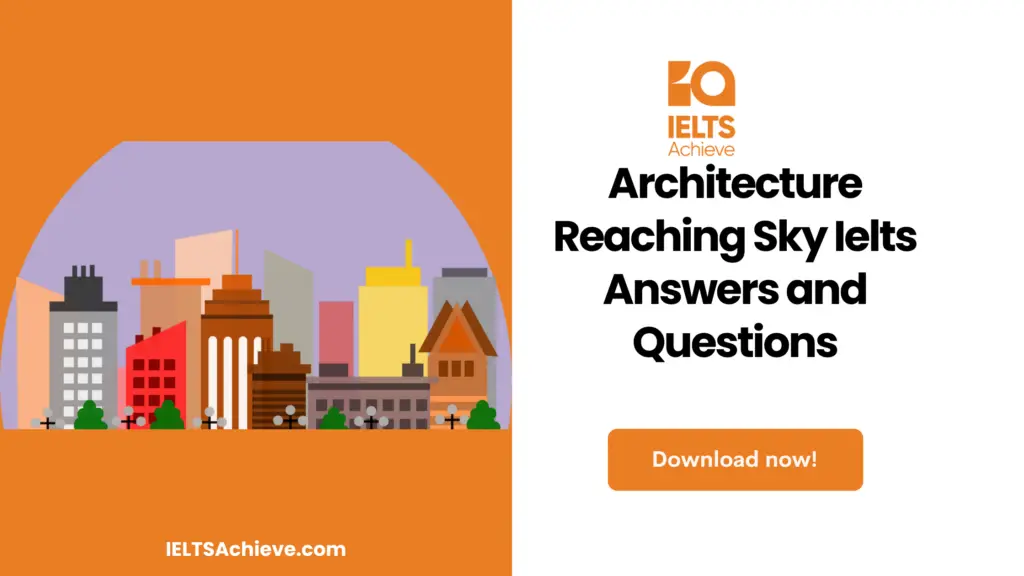The Blog post contains the following IELTS Reading Questions:
- IELTS Reading Matching Headings
- IELTS Reading Matching Features
Stay informed and prepared for success – Explore our comprehensive Reading Test Info page to get valuable insights, exam format details, and expert tips for mastering the IELTS Reading section.
IELTS Reading Passage – Psychological Value Of Space

Psychological Value Of Space
A What would a building space look and feel like if it were designed to promote psychological and social well-being? How would it affect the senses, the emotions, and the mind? How would it affect behavioral patterns? For insights, it is useful to look not at buildings, but at zoos. Zoo design has gone through a radical transformation in the past several decades. Cages have been replaced by natural habitats and geographic clustering of animals. In some places, the animals are free-ranging and the visitors are enclosed in buses or trains moving through the habitat. Animals now exist in mixed species exhibits more like their natural landscapes. And, as in nature, the animals have much greater control over their behavior. They can be on view if they want, or out of sight. They forage, play, rest, mate and act like normal animals.
B What brought about this transformation in philosophy and design? A key factor was concern over the animals’ psychological and social well-being. Zoos could keep animals alive, but they couldn’t make them flourish. Caged animals often exhibit neurotic behaviors—pacing, repetitive motions, aggression, and withdrawal. In one famous example, an animal psychologist was hired by the Central Park Zoo to study a polar bear that spent the day swimming in endless figure eights in its small pool. This was not normal polar bear behavior and the zoo was concerned about it. After several days of observation, the animal psychologist offered a diagnosis. The bear was bored. To compensate for this unfortunate situation, the zoo added amenities and toys to the bear’s enclosure to encourage exploration and play.
C Are there lessons that we can apply to building design? Some experts believe so: for example, biologist Stephen Boyden (1971) defines the optimum healthy environment as ‘the conditions which tend to promote or permit an animal optimal physiological, mental, and social performance in its natural or “evolutionary” environment.’ Because humans evolved in a natural landscape, it is reasonable to turn to the natural environment for clues about preference patterns that may be applicable to building design. Drawing on habitat selection theory, ecologist Gordon Orians argues that humans are psychologically adapted to and prefer landscape features that characterized the African plain or savannah, the presumed site of human evolution. Although humans now live in many different habitats, Orians argues that our species’ long history as mobile hunters and gatherers on the African savannahs should have left its mark on our psyche. If the ‘savannah hypothesis’ is true, we would expect to find that humans intrinsically like and find pleasurable environments that contain the key features of the savannah most likely to have aided our ancestors’ survival and well-being.
D Although Boyden distinguishes between survival and well-being needs, they often overlap. For example, people clearly need food for survival and health. However, food often serves as the basis for bonding and relationship development. The ritual of sitting around a fire on the savannah or in a cave telling stories of the day’s events and planning for tomorrow may be an ancient carryover from Homo-Sapiens’ hunting and gathering days. According to anthropologist Melvin Konner, the sense of safety and intimacy associated with the campfire may have been a factor in the evolution of intellectual progression as well as social bonds. Today’s hearth is the family kitchen at home, and the community places, such as cafes and coffee bars, where people increasingly congregate to eat, talk, read and work.
E A growing body of research shows that building environments that connect people to nature are more supportive of human emotional well-being and cognitive performance than environments lacking these features. For instance, research by Roger Ulrich consistently shows that passive viewing of nature through windows promotes positive moods. Similarly, research by Rachel Kaplan found that workers with window views of trees had a more positive outlook on life than those doing similar work but whose window looked out onto a parking lot. Connection to nature also provides mini mental breaks that may aid the ability to concentrate, according to research by Stephen Kaplan. Terry Hartig and colleagues report similar results in a field experiment. People in their study who went for a walk in a predominantly natural setting achieved better on several office tasks requiring concentration than those who walked in a predominantly built setting or who quietly read a magazine indoors.
F Studies of outdoor landscapes are providing evidence that the effects of nature on human health and well-being extend beyond emotional and cognitive functioning to social behavior and crime reduction. For instance, Francis Kuo found that outdoor nature buffers aggression in urban high- rise settings and enhances ability to deal with demanding circumstances. He also reported that planting trees in urban areas increases sociability by providing comfortable places for residents to talk with one another and develop friendships that promote mutual support.
G A natural perspective also contributes important insights into comfort maintenance. Because people differ from one another in many ways (genetics, cultures, lifestyles) their ambient preferences vary. Furthermore, a given person varies over time depending upon his or her state of health, activities, clothing levels, and so forth. For most of human history, people have actively managed their surroundings as well as their behaviors to achieve comfort. Yet buildings continue to be designed with a “one size fits all” approach. Very few buildings or workstations enable occupants to control lighting, temperature, ventilation rates, or noise conditions. Although the technology is largely available to do this, the personal comfort systems have not sold well in the market place, even though research by Walter Kroner and colleagues at Rensselaer Polytechnic Institute shows that personal control leads to significant increases in comfort and morale.
Unlock your full potential in the IELTS Reading section – Visit our IELTS Reading Practice Question Answer page now!
Recommended Questions:
Renewable Energy IELTS Reading Question with Answer
Questions 14-20
Reading Passage 2 has seven paragraphs, A – G.
Choose the correct heading for each paragraph from the list of headings below. Write the correct number i-x in boxes 14 -20 on your answer sheet.
List of Headings
i The influence of the seasons on productivity
ii A natural way to anger management
iii Natural building materials promote health
iv Learning from experience in another field
v Stimulating the brain through internal design features
vi Current effects on the species of ancient experiences
vii Uniformity is not the answer
viii The negative effects of restricted spaces
ix Improving occupational performance
x The modern continuation of ancient customs
14 Paragraph A
15 Paragraph B
16 Paragraph C
17 Paragraph D
18 Paragraph E
19 Paragraph F
20 Paragraph G
Ready to conquer Matching Headings questions? Click here to learn essential tips and techniques for matching headings accurately to paragraphs or sections in the IELTS Reading section.
Questions 21-26
Look at the following people (Questions 21 – 26) and the list of theories below.
Match each person with the correct theory, A —I. Write the correct letter A-1 in boxes 21 -26 on your answer sheet.
21 Gordon Orians
22 Melvin Konner
23 Roger Ulrich
24 Stephen Kaplan
25 Francis Kuo
26 Walter Kroner
List of Theories
A Creating a green area can stimulate a sense of community.
B People need adequate living space in order to be healthy.
C Natural landscape can both relax and sharpen the mind.
D Cooking together is an important element in human bonding.
E People feel more at ease if they can adjust their environment.
F Looking at a green environment improves people’s spirits.
G Physical exercise improves creative thinking at work.
H Man’s brain developed partly through regular association with peers.
I We are drawn to places similar to the area where our species originated.
Improve your performance in Matching Features questions by clicking here to access our comprehensive guide. Learn how to match specific features or characteristics with the options provided in the IELTS Reading section.
Unlock your full potential in the IELTS Reading section – Visit our IELTS Reading Practice Question Answer page now!
Recommended Questions:
Renewable Energy IELTS Reading Question with Answer

We hope you found this post useful in helping you to study for the IELTS Test. If you have any questions please let us know in the comments below or on the Facebook page.
The best way to keep up to date with posts like this is to like us on Facebook, then follow us on Instagram and Pinterest. If you need help preparing for the IELTS Test, join the IELTS Achieve Academy and see how we can assist you to achieve your desired band score. We offer an essay correction service, mock exams and online courses.

